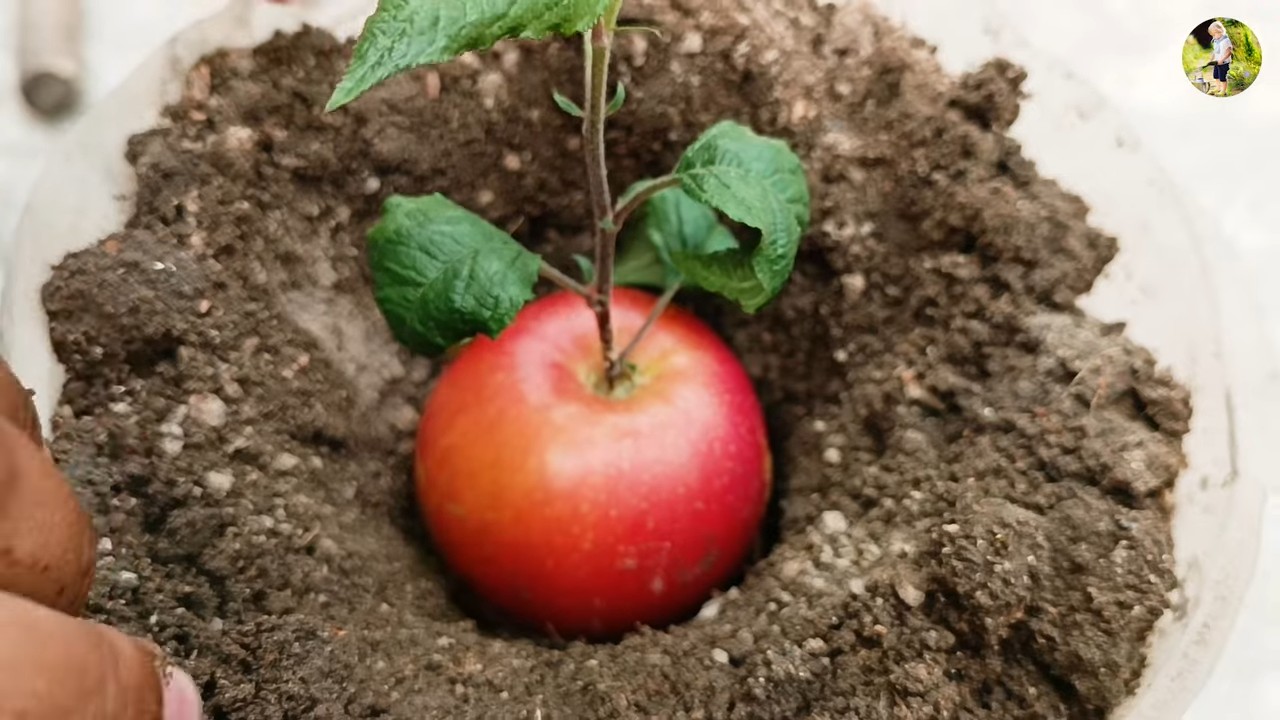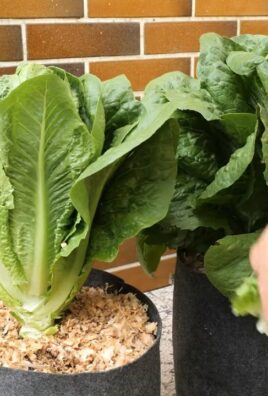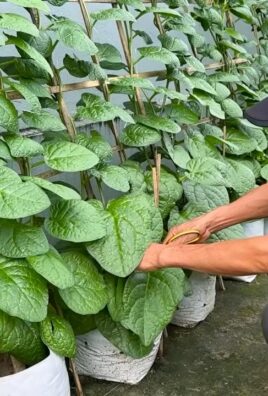Grow Apples Indoors? Absolutely! Imagine plucking a crisp, juicy apple right from a tree in your living room. Sounds like something out of a fairytale, right? Well, it’s more attainable than you might think! For centuries, cultivating fruit trees has been a symbol of prosperity and connection to nature. From ancient Roman orchards to the meticulously planned gardens of the Renaissance, people have always sought ways to bring the bounty of the outdoors closer to home.
While traditionally, apple growing was confined to sprawling orchards, modern techniques and a little DIY ingenuity are making it possible to enjoy the fruits of your labor, literally, even without a backyard. This article is your comprehensive guide to mastering the art of growing apples indoors. We’ll delve into everything from selecting the right apple variety and providing adequate light to ensuring proper pollination and pest control.
Why should you bother learning how to grow apples indoors? Because it’s incredibly rewarding! Not only will you have fresh, organic apples at your fingertips, but you’ll also experience the joy of nurturing a living thing and connecting with nature in a unique and meaningful way. Plus, it’s a fantastic conversation starter! So, grab your gardening gloves, and let’s embark on this exciting indoor apple-growing adventure together!

Growing Apples Indoors: Your DIY Guide for an Indoor Apple Orchard
Hey garden friends! Have you ever dreamed of harvesting your own apples, right in your living room? Sounds crazy, right? But it’s absolutely doable! I’ll show you how, with a little patience and the right tricks, you can grow your own indoor apple trees. It’s an exciting project that is not only fun but also rewards you with fresh, homegrown apples. Let’s get started!
The Basics: What You Need to Get Started
Before we dive into the adventure, we need the right equipment. Here is a list of everything you’ll need for your indoor apple tree project:
- Apple tree seedling or grafted dwarf apple tree: This is the heart of our project. Be sure to choose a dwarf variety that is suitable for growing in pots. Varieties like ‘Gala,’ ‘Fuji,’ or ‘Honeycrisp’ are good options. A grafted tree is often the better choice as it bears fruit more quickly.
- Large pot: Choose a pot with a diameter of at least 45 cm (18 inches) and a depth of 45 cm. This gives the roots enough space to grow.
- High-quality potting soil: Well-draining potting soil is crucial. It’s best to mix potting soil with some compost and perlite to improve drainage.
- Plant stake: A plant stake helps to support the young tree, especially when it’s bearing fruit.
- Fertilizer: A balanced fertilizer for fruit trees is important to provide the tree with the necessary nutrients.
- Garden shears: Sharp garden shears are essential for pruning.
- Spray bottle: For moistening the leaves.
- Grow light (optional): If you don’t have enough sunlight, a grow light can help.
- Patience: The most important thing of all! Apple trees take time to grow and bear fruit.
Step-by-Step Guide: Your Indoor Apple Tree Project
Now that we have everything, we can get started! Here is a detailed guide on how to plant and care for your own indoor apple tree:
1. Choosing the Right Apple Tree:
- Choose a dwarf variety: As mentioned, choosing a dwarf variety is crucial. These varieties are specially bred to stay small and thrive in pots.
- Prefer a grafted tree: A grafted tree is one where a shoot of a desired apple variety has been grafted onto the root of another, more resilient variety. This results in a tree that bears fruit faster and is more resistant to diseases.
- Select a healthy tree: When buying, look for a healthy tree with strong leaves and no signs of diseases or pests. The roots should be well-developed but not circling in the pot.
2. Preparing the Pot:
- Pot size: Choose a pot with a diameter of at least 45 cm (18 inches) and a depth of 45 cm. A larger pot is better as it gives the roots more space to grow.
- Drainage holes: Make sure the pot has drainage holes so excess water can escape. Waterlogging can lead to root rot.
- Drainage layer: Place a layer of clay shards or gravel at the bottom of the pot to improve drainage.
3. Planting the Apple Tree:
- Fill the pot with soil: Fill the pot with the prepared potting soil. Leave about 5 cm (2 inches) of space to the rim of the pot.
- Carefully remove the tree from the pot: Gently take the apple tree out of its original pot. Loosen the roots slightly if they are circling.
- Place the tree: Place the tree in the center of the pot. The top of the root ball should be about 2-3 cm (1 inch) below the rim of the pot.
- Fill with soil: Fill the pot with soil and press it down lightly.
- Water thoroughly: Water the tree thoroughly until water runs out of the drainage holes.
4. Placing the Tree Correctly:
- Sunlight: Apple trees need at least 6-8 hours of sunlight per day. Place the tree in a sunny location, such as a south-facing window.
- Grow light (optional): If you don’t have enough sunlight, you can use a grow light. Position the lamp about 30-60 cm (12-24 inches) above the tree.
- Rotate: Rotate the tree regularly so that all sides receive even light.
The Care: How to Keep Your Apple Tree Happy and Healthy
Proper care is crucial for your indoor apple tree to thrive and bear fruit. Here are some important tips:
1. Watering:
- Water regularly: Water the tree regularly, but avoid waterlogging. The soil should be moist, but not wet.
- Finger test: Do the finger test to determine if the tree needs water. Stick your finger about 2-3 cm (1 inch) deep into the soil. If the soil feels dry, it’s time to water.
- Watering time: It’s best to water in the morning so the leaves can dry during the day.
- Water quality: It’s best to use rainwater or tap water that has been left to sit out.
2. Fertilizing:
- Fertilize regularly: Fertilize the tree regularly during the growing season (spring and summer) with a balanced fertilizer for fruit trees.
- Dosage: Follow the instructions on the fertilizer package.
- Fertilizing time: Fertilize the tree every 2-4 weeks.
- Winter break: In winter, the tree needs less fertilizer. Reduce or stop fertilizing completely.
3. Pruning:
- Prune regularly: Prune the tree regularly to maintain its shape and encourage fruit production.
- Remove dead wood: Remove dead, diseased, or damaged wood.
- Thinning: Thin out the tree to improve air circulation and allow sunlight to reach the interior of the tree.
- Shaping: Shape the tree to maintain a good structure.
- Pruning time: It’s best to prune the tree in late winter or early spring before new growth begins.
4. Pollination:
- Hand pollination: Since there are no bees or other insects indoors, you will have to do the pollination yourself.
- Brush method: Take a small brush and transfer the pollen from one flower to another.
- Timing: Pollinate the flowers when they are open and the pollen is visible.
- Repetition: Repeat the pollination several times to ensure that all flowers are pollinated.
5. Pests and Diseases:
Common pests: Aphids, spider mites, and mealybugs are common pests on apple trees.
Regular checks: Check the tree regularly for pests and diseases.

Conclusion
So, there you have it! Growing apples indoors might seem like a horticultural high-wire act, but with the right knowledge, a little patience, and a dash of dedication, you can absolutely enjoy the fruits (pun intended!) of your labor right in your own home. This DIY trick isn’t just about having fresh apples readily available; it’s about connecting with nature, learning a new skill, and experiencing the sheer joy of nurturing a living thing from seedling to harvest.
Why is this a must-try? Because it’s more than just growing food. It’s about sustainability, reducing your carbon footprint, and knowing exactly where your food comes from. Imagine the satisfaction of biting into a crisp, juicy apple that you personally cultivated, free from pesticides and full of flavor. It’s a conversation starter, a unique hobby, and a testament to your green thumb (or soon-to-be green thumb!).
But don’t stop there! Experiment with different apple varieties suited for container growing. Try dwarf varieties like ‘Gala,’ ‘Fuji,’ or ‘Honeycrisp’ for the best results. Consider grafting different varieties onto a single rootstock for a multi-apple tree! You can also explore different training methods, such as espalier, to maximize space and create a stunning living art piece. Think about adding companion plants to your container to attract pollinators and deter pests naturally. Marigolds, basil, and nasturtiums are excellent choices.
Remember, success in indoor apple growing hinges on providing the right conditions: ample sunlight (or a good grow light), well-draining soil, consistent watering, and proper pollination. Don’t be afraid to adjust your approach as you learn what works best for your specific environment.
We wholeheartedly encourage you to embark on this exciting journey of growing apples indoors. It’s a rewarding experience that will connect you with nature in a profound way. And most importantly, share your experiences! Let us know what varieties you’re growing, what challenges you’ve faced, and what successes you’ve celebrated. Your insights can help other aspiring indoor apple growers and contribute to a thriving community of home orchardists. So, grab your seeds, pots, and soil, and get ready to enjoy the delicious rewards of your indoor apple-growing adventure! Let’s cultivate a greener, more sustainable future, one apple tree at a time.
Frequently Asked Questions (FAQ)
1. What are the best apple varieties to grow indoors?
Dwarf apple varieties are generally the best choice for indoor growing due to their smaller size and adaptability to container life. Some excellent options include:
* **’Gala’:** A popular, sweet, and crisp apple that is relatively easy to grow.
* **’Fuji’:** Another sweet and crisp variety that stores well.
* **’Honeycrisp’:** Known for its exceptional crispness and sweet-tart flavor.
* **’Golden Delicious’:** A classic, all-purpose apple with a mild flavor.
* **’Red Delicious’:** While not as flavorful as some other varieties, it’s readily available and can be grown indoors.
When selecting a variety, consider its chill hour requirements. Some apple varieties need a certain number of hours below a specific temperature (usually between 32°F and 45°F) to properly set fruit. Choose varieties with lower chill hour requirements or find ways to artificially chill your tree during the dormant season.
2. How much sunlight do indoor apple trees need?
Apple trees require a significant amount of sunlight to thrive and produce fruit. Ideally, they need at least 6-8 hours of direct sunlight per day. If you don’t have a south-facing window that provides sufficient sunlight, you’ll need to supplement with grow lights.
Full-spectrum LED grow lights are an excellent option. Position the lights about 12-18 inches above the tree canopy and ensure they cover the entire plant. You can use a timer to automate the lighting schedule.
3. What type of soil is best for growing apples in containers?
Well-draining soil is crucial for preventing root rot, a common problem with container-grown plants. A good potting mix for apple trees should be a blend of:
* **Potting soil:** Provides essential nutrients and moisture retention.
* **Perlite:** Improves drainage and aeration.
* **Peat moss or coco coir:** Enhances water retention and adds organic matter.
Avoid using garden soil, as it can become compacted in containers and doesn’t drain well. You can also add a slow-release fertilizer to the potting mix to provide a steady supply of nutrients.
4. How often should I water my indoor apple tree?
Watering frequency depends on several factors, including the size of the container, the type of soil, the temperature, and the humidity. Generally, you should water your apple tree when the top inch of soil feels dry to the touch.
Water thoroughly until excess water drains out of the bottom of the container. Avoid overwatering, as this can lead to root rot. During the dormant season, reduce watering frequency.
5. How do I pollinate my indoor apple tree?
Since there are no bees or other pollinators indoors, you’ll need to hand-pollinate your apple tree. Use a small, soft brush (like an artist’s paintbrush) to transfer pollen from the stamen (the male part of the flower) to the pistil (the female part of the flower).
Gently brush the pollen onto the pistil of each flower. You may need to do this several times over a few days to ensure successful pollination. Alternatively, you can use a cotton swab to collect pollen and then gently dab it onto the pistils.
6. How do I fertilize my indoor apple tree?
Apple trees need regular fertilization to provide the nutrients they need to grow and produce fruit. Use a balanced fertilizer specifically formulated for fruit trees. Follow the instructions on the fertilizer label for application rates and frequency.
During the growing season (spring and summer), fertilize every 2-4 weeks. Reduce or stop fertilizing during the dormant season (fall and winter). You can also supplement with organic fertilizers like compost tea or fish emulsion.
7. How do I prune my indoor apple tree?
Pruning is essential for maintaining the shape and health of your apple tree. Prune in late winter or early spring, before new growth begins. Remove any dead, damaged, or crossing branches.
Also, prune to improve air circulation and light penetration within the tree canopy. You can also prune to encourage fruit production by removing some of the previous year’s growth.
8. How do I deal with pests and diseases on my indoor apple tree?
Even indoors, apple trees can be susceptible to pests and diseases. Common pests include aphids, spider mites, and scale. Common diseases include powdery mildew and apple scab.
Inspect your tree regularly for signs of pests or diseases. If you find any, treat them promptly with appropriate organic pesticides or fungicides. You can also use insecticidal soap or neem oil to control pests. Good air circulation and proper watering can help prevent diseases.
9. How long does it take for an indoor apple tree to produce fruit?
It typically takes 2-3 years for an apple tree to start producing fruit, even under ideal conditions. Grafted trees may produce fruit sooner than trees grown from seed. Patience is key!
10. Can I grow an apple tree from seed indoors?
While it’s possible to grow an apple tree from seed, it’s not recommended for fruit production. Apple trees grown from seed often don’t produce fruit that is true to the parent variety. They also take much longer to mature and produce fruit (5-10 years).
If you want to grow apples indoors, it’s best to purchase a grafted dwarf apple tree from a reputable nursery. Grafted trees are more likely to produce fruit that is true to the variety and will mature much faster.





Leave a Comment